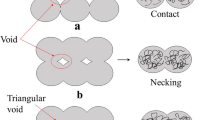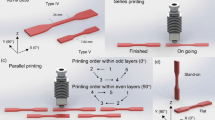Abstract
Polypropylene (PP) is a highly desirable polyolefin in various plastic industries due to its outstanding thermomechanical properties and chemical resistance. Therefore, the 3D printing of PP is an interesting avenue to explore in digitized manufacturing, where more freedom in structural designs is available for new and extended applications, such as high-performance engineering parts. In this work, we 3D printed PP and studied the effect of printing parameters and post-processing conditions on the printed polymer’s thermomechanical behavior. Results showed that nozzle and bed temperatures of 220 and 100°C produced a high printing quality. Infill percentages between 80 and 90%, coupled with a 4-h annealing at 110ºC, also resulted in optimal printed properties. It is thought that PP can be potentially blended with polyethylene or other vinyl polymers for a more extended 3D printing utility and practical applications in rapid tooling and prototyping.
Graphical abstract





Similar content being viewed by others
Data availability
Additional data are available with the supplementary information file that will be made accessible with publication. In addition, more data and inquiry are possible through communication with the authors.
References
M. Tolinski, Additives for Polyolefins: Getting the Most Out of Polypropylene, Polyethylene and TPO (William Andrew, Oxford, 2015)
N.K. Boaen, M.A. Hillmyer, Post-polymerization functionalization of polyolefins. Chem. Soc. Rev. 34(3), 267 (2005)
A. Ammala, S. Bateman, K. Dean, E. Petinakis, P. Sangwan, S. Wong, Q. Yuan, L. Yu, C. Patrick, K. Leong, An overview of degradable and biodegradable polyolefins. Prog. Polym. Sci. 36(8), 1015 (2011)
J. Gulmine, P. Janissek, H. Heise, L. Akcelrud, Polyethylene characterization by FTIR. Polym. Test. 21(5), 557 (2002)
F. Padden Jr., H. Keith, Spherulitic crystallization in polypropylene. J. Appl. Phys. 30(10), 1479 (1959)
E.B. Caldona, J.M.C. Albayalde, A.M.P. Aglosolos, K.S. Bautista, M.D. Tavora, S.A.P. Cabalza, J.R.O. Diaz, M.D. Mulato, Titania-containing recycled polypropylene surfaces with photo-induced reversible switching wettability. J. Polym. Environ. 27(7), 1564 (2019)
A. Peacock, Handbook of Polyethylene: Structures: Properties, and Applications (CRC Press, Boca Raton, 2000)
A.-C. Albertsson, S.O. Andersson, S. Karlsson, The mechanism of biodegradation of polyethylene. Polym. Degrad. Stab. 18(1), 73 (1987)
J.D. Burguillos, E.B. Caldona, Design and development of a novel waste container from HDPE-layered bins. J. King Saud Univ. Eng. Sci. 32(1), 85 (2020)
N. Pasquini, A. Addeo, Polypropylene Handbook (Hanser Publishers, Munich, 2005)
G. Natta, P. Corradini, Stereospecific Polymers (Elsevier, Amsterdam, 1967), pp.743–746
P. Choi, W. Mattice, Molecular origin of demixing, prior to crystallization, of atactic polypropylene/isotactic polypropylene blends upon cooling from the melt. J. Chem. Phys. 121, 8647 (2004)
J. Chen, F. Tsai, Y. Nien, P. Yeh, Isothermal crystallization of isotactic polypropylene blended with low molecular weight atactic polypropylene Part I. Thermal properties and morphology development. Polymer 46(15), 5680 (2005)
A. Dawood, B.M. Marti, V. Sauret-Jackson, A. Darwood, 3D printing in dentistry. Br. Dent. J. 219(11), 521 (2015)
Z. Chen, Z. Li, J. Li, C. Liu, C. Lao, Y. Fu, C. Liu, Y. Li, P. Wang, Y. He, 3D printing of ceramics: a review. J. Eur. Ceram. Soc. 39(4), 661 (2019)
N. Shahrubudin, T.C. Lee, R. Ramlan, An overview on 3D printing technology: technological, materials, and applications. Procedia Manuf. 35, 1286 (2019)
R.C. Advincula, J.R.C. Dizon, E.B. Caldona, R.A. Viers, F.D.C. Siacor, R.D. Maalihan, A.H. Espera, On the progress of 3D-printed hydrogels for tissue engineering. MRS Commun. 11(5), 539 (2021)
J.R.H.S. Agueda, Q. Chen, R.D. Maalihan, J. Ren, Í.G. da Silva, N.P. Dugos, E.B. Caldona, R.C. Advincula, 3D printing of biomedically relevant polymer materials and biocompatibility. MRS Commun. 11, 197 (2021)
A.C.C. de Leon, Í.G. da Silva, K.D. Pangilinan, Q. Chen, E.B. Caldona, R.C. Advincula, High performance polymers for oil and gas applications. React. Funct. Polym. 162, 104878 (2021)
D.B. Gutierrez, E.B. Caldona, R.D. Espiritu, R.C. Advincula, The potential of additively manufactured membranes for selective separation and capture of CO2. MRS Commun. 11(4), 391 (2021)
Q. Chen, J.D. Mangadlao, J. Wallat, A. De Leon, J.K. Pokorski, R.C. Advincula, 3D printing biocompatible polyurethane/poly (lactic acid)/graphene oxide nanocomposites: anisotropic properties. ACS Appl. Mater. Interfaces 9(4), 4015 (2017)
A.C. de Leon, Q. Chen, N.B. Palaganas, J.O. Palaganas, J. Manapat, R.C. Advincula, High performance polymer nanocomposites for additive manufacturing applications. React. Funct. Polym. 103, 141 (2016)
V.S. Voet, T. Strating, G.H. Schnelting, P. Dijkstra, M. Tietema, J. Xu, A.J. Woortman, K. Loos, J. Jager, R. Folkersma, Biobased acrylate photocurable resin formulation for stereolithography 3D printing. ACS Omega 3(2), 1403 (2018)
J.Z. Manapat, Q. Chen, P. Ye, R.C. Advincula, 3D printing of polymer nanocomposites via stereolithography. Macromol. Mater. Eng. 302(9), 1600553 (2017)
R.D. Maalihan, Q. Chen, J.R.H.S. Agueda, B.B. Pajarito, H. Tamura, R.C. Advincula, On the use of surfactant-complexed chitosan for toughening 3D printed polymethacrylate composites. Macromol. Mater. Eng. 306(1), 2000448 (2021)
X. Wan, L. Luo, Y. Liu, J. Leng, Direct ink writing based 4D printing of materials and their applications. Adv. Sci. 7(16), 2001000 (2020)
Q. Chen, P. Cao, R.C. Advincula, Mechanically robust, ultraelastic hierarchical foam with tunable properties via 3D printing. Adv. Funct. Mater. 28(21), 1800631 (2018)
Q. Chen, J. Zhao, J. Ren, L. Rong, P. Cao, R.C. Advincula, 3D printed multifunctional, hyperelastic silicone rubber foam. Adv. Funct. Mater. 29(23), 1900469 (2019)
A. Awad, F. Fina, A. Goyanes, S. Gaisford, A.W. Basit, 3D printing: Principles and pharmaceutical applications of selective laser sintering. Int. J. Pharm. 586, 119594 (2020)
A.H. Espera Jr., A.D. Valino, J.O. Palaganas, L. Souza, Q. Chen, R.C. Advincula, 3D Printing of a robust polyamide-12-carbon black composite via selective laser sintering: thermal and electrical conductivity. Macromol. Mater. Eng. 304(4), 1800718 (2019)
L. Wu, Z. Dong, F. Li, H. Zhou, Y. Song, Emerging progress of inkjet technology in printing optical materials. Adv. Opt. Mater. 4(12), 1915 (2016)
A.D. Valino, J.R.C. Dizon, A.H. Espera Jr., Q. Chen, J. Messman, R.C. Advincula, Advances in 3D printing of thermoplastic polymer composites and nanocomposites. Prog. Polym. Sci. 98, 101162 (2019)
J.R.C. Dizon, A.H. Espera Jr., Q. Chen, R.C. Advincula, Mechanical characterization of 3D-printed polymers. Addit. Manuf. 20, 44 (2018)
A. Gudadhe, N. Bachhar, A. Kumar, P. Andrade, G. Kumaraswamy, Three-dimensional printing with waste high-density polyethylene. ACS Appl. Polym. Mater. 1(11), 3157 (2019)
D. Filgueira, S. Holmen, J.K. Melbø, D. Moldes, A.T. Echtermeyer, G. Chinga-Carrasco, 3D printable filaments made of biobased polyethylene biocomposites. Polymers 10(3), 314 (2018)
C. Minogianni, K.G. Gatos, C. Galiotis, Estimation of crystallinity in isotropic isotactic polypropylene with Raman spectroscopy. Appl. Spectrosc. 59(9), 1141 (2005)
K. Lau, P. Hung, M.-H. Zhu, D. Hui, Properties of natural fibre composites for structural engineering applications. Composite B 136, 222 (2018)
F.D.C. Siacor, Q. Chen, J.Y. Zhao, L. Han, A.D. Valino, E.B. Taboada, E.B. Caldona, R.C. Advincula, On the additive manufacturing (3D printing) of viscoelastic materials and flow behavior: from composites to food manufacturing. Addit. Manuf. 45, 102043 (2021)
Acknowledgments
The authors gratefully acknowledge funding from the Governor’s Chair Funds, the University of Tennessee System, and the Center for Materials Processing (CMP)-TCE. Technical support from Malvern Panalytical, Frontier Laboratories and Quantum Analytics are also acknowledged. Work (or part of this work) was conducted by ORNL’s Center for Nanophase Materials and Sciences by RCA, a US Department of Energy Office of Science User Facility.
Author information
Authors and Affiliations
Corresponding author
Ethics declarations
Conflict of interest
On behalf of all authors, the corresponding author states that there is no conflict of interest.
Additional information
Publisher's Note
Springer Nature remains neutral with regard to jurisdictional claims in published maps and institutional affiliations.
Rigoberto C. Advincula was an editor of this journal during the review and decision stage. For the MRS Communications policy on review and publication of manuscripts authored by editors, please refer to http://www.mrs.org/editormanuscripts/.
Supplementary Information
Below is the link to the electronic supplementary material.
Rights and permissions
Springer Nature or its licensor (e.g. a society or other partner) holds exclusive rights to this article under a publishing agreement with the author(s) or other rightsholder(s); author self-archiving of the accepted manuscript version of this article is solely governed by the terms of such publishing agreement and applicable law.
About this article
Cite this article
Moczadlo, M., Chen, Q., Cheng, X. et al. On the 3D printing of polypropylene and post-processing optimization of thermomechanical properties. MRS Communications 13, 169–176 (2023). https://doi.org/10.1557/s43579-023-00329-2
Received:
Accepted:
Published:
Issue Date:
DOI: https://doi.org/10.1557/s43579-023-00329-2




